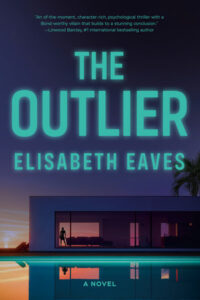Psychopathology of everyday CEOs
The Outlier
by Elisabeth Eaves
Toronto: Random House Canada, 2024
$24.95 / 9781039008045
Reviewed by Jessica Poon
*

What do schools of dead fish, a cure for Alzheimer’s, and nuclear fusion have in common? They’re all key components in The Outlier by Vancouver-raised Elisabeth Eaves, a thriller that is more of a psychological exploration than a brain-breaking whodunit.
Cate is a neuroscientist who’s about to become incredibly wealthy after inventing a cure for Alzheimer’s. Her business partner, Jia, has no idea that Cate is a psychopath—and a very functioning, seemingly empathetic one at that. The only person who Cate’s ever told is her ex-boyfriend, Gabriel, a marine biologist. The dissolution for their relationship, is inextricably entwined with Cate’s vulnerable admission.
When Cate first appears on the page, she changes from her work clothes to waiting-at-a-hotel-bar-for-someone-hot-to-show-up clothes. It’s clear that Cate is not after substantive love and bouquets; rather, she has a libido and knows how to fulfill it. It’s not long before she pairs off with a journalist, who fails to let on that he recognized her—and that he has a girlfriend. Cate longs to commit death by stiletto, but because she is an exemplar of restraint, she does not.
After the death of her stepbrother and her mother, Cate was sent to live at the Cleckley Institute in rural Washington state, run by Dr. M, an avuncular figure who is immensely proud of not only Cate’s career, but her ability to blend in with neurotypical people. In Cate’s words:
The Cleckley subjects fell into two categories. First, the outright criminals. I didn’t even finish scanning their list of offences. The other, more numerous cohort somehow depressed me more, even though they performed “better” at life. They’d stayed out of jail. They’d job-hopped and marriage-hopped…. Tediously scraped by. But they’d avoided criminality, which made them the study’s success stories. Left untreated, … 80 to 90 percent of these individuals would have committed crimes, but after their time at Cleckley, less than half did.
Of course, Cate’s success goes beyond avoiding crime—she’s a Cleckley superstar.
The only other Cleckley alumnus with incredibly impressive career success is Number 98, who turns out to be Hunter Araya, formerly Hunter Bendt, an engineer fascinated by nuclear fusion. Both Cate and Hunter have empathy deficits compared to neurotypical people, but they are also exceedingly pragmatic when it comes to solutions for real problems (see: a cure for Alzheimer’s, nuclear fusion).
Cate is aware of the romanticizing of the genius psychopath:
Popular entertainment loves the idea of the genius psychopath, but the truth is much more banal. In practical intelligence, in fact, psychopaths are on average stupider than other groups, dragged down by a propensity for bad decision-making. It doesn’t matter how high you score on an IQ test if you have no impulse control…. I still say it to myself, regularly, lest I forget.
The exploration of Cate and Hunter’s respective youth of learning how to be in society—rule number one, don’t talk about Cleckley—defies the usual stereotypes of juvenile psychiatric institutions being repositories of endless child abuse. While it can be dismaying to read about a sentient human being as a number, Dr. M genuinely wants his subjects—or surrogate children—to do well.
Dr. M advises Cate not to go looking for Hunter, but Cate isn’t one to listen to orders.

Cate remembers wanting to kiss Hunter when she was thirteen. She also remembers that he was friends with Terry, a fellow Cleckley resident who died in what appeared to be a tragic fall during a hike. Cate’s desire for proof that she’s not a congenitally reprehensible person leads her to projects that desire onto Hunter. If he’s a good person, then there’s hope for her as well.
All these fraught inquiries provoke the question as to whether Cate actually fits the diagnosis she has been given, but periodically, we are reminded of thwarted death by stiletto. By far, Cate’s most successful technique for blending in is hilariously simple: “In real life, people were too busy thinking about their own needs…. If you give other people the attention they want and don’t act too eccentric, they forget to wonder about you.”
Meanwhile, Luciana, a scientist, is trying to figure out why red snappers keep dying in masses that not even bycatch can account for. To date, this novel is the only thriller I’ve ever read that mentions bycatch in passing, so kudos. Luciana’s trying to keep her connection to Javier, the leader of Reef Pirates, on the down low. Her husband, Dario, just wants the resort he looks after to remain profitable after a new competing resort opens.
It takes a while before a character known to the reader dies. Cate and Jia are supposed to be in we’re-billionaires-now vacation mode, but instead, Cate is trying to learn more about Hunter. That leads them to improbably pleasurable sex and, arguably more importantly, the relief of meeting someone who truly understands being anomalous. Cate, fascinated by the numerous deaths of red snappers, asks her ex, Gabriel, to investigate.
Where this debut novel by Eaves (Wanderlust: A Love Affair with Five Continents) succeeds is its structure—Cate gets a first person point of view, and everyone else takes turns with a third-person limited view that emphasizes Cate as the protagonist but permits the reader to appreciate others’ perspectives. I would have liked to have heard more about Cate’s cure for Alzheimer’s, which was inspired by Cate’s grandmother’s death. There are times when Cate’s reflection on being able to appreciate the outcome, over an ethically troubling process, brought to mind Dostoyevsky’s Crime and Punishment. I would have enjoyed more of Cate’s personal ruminations on trolley problem-esque scenarios, either theoretically or in actuality.
For such an atypical brain with superlative achievements, I did often feel as though I was in the mind of neurotypical person with an average knowledge of science. That could be a testament to how even wildly accomplished geniuses are just like us—or, perhaps, Cate’s talent for mimicking neurotypicals has become a permanent mask.
Mostly, The Outlier is an enjoyable, commendably environment-aware thriller with an interesting evocation on how much—or how little—our brains are akin to who we are as people.
[Editor’s note: The Vancouver launch for The Outlier will be Tuesday, Aug 13 at 7pm, 1387 Railspur Alley, Granville Island.]
*

Originally from East Vancouver, Jessica Poon is a writer, former line cook, and pianist of dubious merit who recently returned to BC after completing a MFA in Creative Writing at the University of Guelph. [Editor’s note: Jessica Poon has reviewed books by Rajinderpal S. Pal, Keziah Weir, Amber Cowie, Robyn Harding, Roz Nay, Anne Fleming, Miriam Lacroix, Taslim Burkowicz, Sam Wiebe, Amy Mattes, Louis Druehl, Sheung-King, Loghan Paylor, Lisa Moore (ed.), Sandra Kelly, Robyn Harding, Ian and Will Ferguson, Christine Lai, Logan Macnair, Jen Sookfong Lee, J.M. Miro (Steven Price), Bri Beaudoin, Tetsuro Shigematsu, Katie Welch, Megan Gail Coles, and Ayesha Chaudhry for BCR]
*
The British Columbia Review
Interim Editors, 2023-25: Trevor Marc Hughes (non-fiction), Brett Josef Grubisic (fiction and poetry)
Publisher: Richard Mackie
Formerly The Ormsby Review, The British Columbia Review is an online book review and journal service for BC writers and readers. The Advisory Board now consists of Jean Barman, Wade Davis, Robin Fisher, Barry Gough, Hugh Johnston, Kathy Mezei, Patricia Roy, Maria Tippett, and Graeme Wynn. Provincial Government Patron (since September 2018): Creative BC. Honorary Patron: Yosef Wosk. Scholarly Patron: SFU Graduate Liberal Studies. The British Columbia Review was founded in 2016 by Richard Mackie and Alan Twigg.
“Only connect.” – E.M. Forster
One comment on “Psychopathology of everyday CEOs”